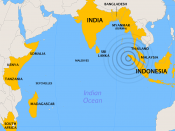In the wake of the December 26, 2004, tsunami that hit coastal villages and towns alongside the Indian Ocean, little thought has been given to another problem very near at hand. The Pew Center on Global Climate Change has released a report that states due to the warming of the oceans and melting of the polar ice caps, sea levels are expected to rise twenty centimeters by 2100 (7). Many have not given thought to this information and it's inherent ramifications. With rising sea levels, catastrophes such as the Indian Ocean tsunami could become an everyday occurrence. The Environmental Protection Agency's response to this issue is to "relocate and rebuild," which could cost billions of dollars and the forfeit of many of our country's most historical buildings to the sea. I think that with proper planning and execution, however, we can preserve our national heritage and lifestyles with a few steps of protection.
The first step to protect our coastlines from the seemingly insurmountable conundrum of the sea is to impede its rise in the first place. This can be done by cutting the emissions of ozone depleting chlorofluorocarbons. CFC's, as they have come to be known, trap the ultra violent rays emitted by the sun, turning the earth into a virtual oven (1). This not only melts the polar ice caps but also helps to warm the seas, thus creating higher sea levels as well as increased storm frequency(1). The cutting of the emission of CFC's can only come from government regulation as well as residential cooperation. Residential emissions can be cut down by car pooling, saving electricity, and using more environmentally friendly materials. Corporate cooperation coupled with government regulation can also eliminate wasteful CFC emissions. International regulation on CFC emissions, such as the Kyoto Protocol, will cost businesses...


